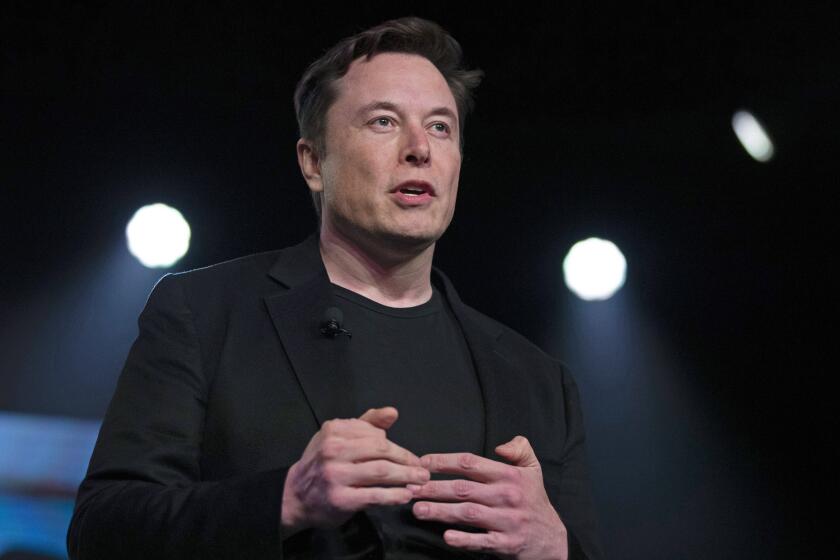Waze will roll out its carpool app across California
- Share via
Reporting from San Francisco — Uber and Lyft talk a big game about transforming the roads, increasing carpooling and reducing traffic. And while both companies have succeeded in getting people used to the idea of hiring an on-demand chauffeur and sharing that ride with strangers, neither has cracked the code for traditional carpooling.
So Waze, the Alphabet-owned mapping and navigation app, is giving it a shot.
On June 6, Waze will launch a carpooling app across California that lets drivers offer rides to people traveling on a similar route. Passengers who wish to carpool with a driver will be able to download a separate app called Waze Carpool and request a ride.
Unlike Uber and Lyft, which take a commission from each ride and whose drivers use it as a source of income, Waze Carpool operates more like an old-school carpool, where riders chip in only to cover the cost of gas. The result is that passengers get an affordable and convenient ride, while drivers get gas money and, in some cases, enough bottoms in seats to use carpool lanes.
Waze has been testing the service in the San Francisco Bay Area and Israel for the last year. While the company declined to share data on usage, it described the tests as “thriving” — good enough for the service to be rolled out to the rest of California.
At the time of the statewide launch, Waze will not take a commission, although in Israel it takes a 15% commission on each ride.
“In the future when we think the service is operating at a quality that warrants a commission, we’ll add a commission,” said Josh Fried, Waze’s head of carpool.
Riders will also pay no more than the IRS’ mileage reimbursement rate of 54 cents per mile, all of which will go to the driver, Fried said.
The noncommercial nature of the rides means that drivers will not have to carry commercial car insurance, nor will they have to undergo background checks, which Uber, Lyft and taxi drivers must undergo before they can drive for those services.
“In terms of vetting drivers, they’re not our employees or independent contractors,” Fried said. “They’re regular, everyday drivers.”
Still, there will be safety features familiar to anyone who has used Uber or Lyft. Drivers and passengers will be able to upload a photo of themselves to the app. There’s a five-star rating system, rider and driver endorsements, and the ability to communicate within the app so that no one has to reveal a phone number. Users will also be able to link to their Facebook and LinkedIn accounts.
Those looking to carpool will be able to reserve rides up to seven days in advance. In Israel, Fried said passengers tend to request their rides the day before or the morning of, whereas in the San Francisco Bay Area, passengers plan their commutes more carefully and book days in advance. The service isn’t intended to offer a ride on demand, but riders can request and get a ride at any time, depending on driver availability.
The company doesn’t see its carpooling service being in competition with Uber, Lyft or taxis, Fried said, because unlike ride-hailing firms, which make money by collecting fares from passengers, Waze makes money from displaying advertisements in the app. In discussing the company’s long-term strategy, Fried said there’s an opportunity for Waze to advertise to people who have never used the Waze mapping app before.
Transportation analysts see a similar opportunity. The company currently shows advertisements to drivers when they are stopped at a light for a period of time, or when they pass certain locations.
“But with carpooling, they have the potential to show ads to more people. They can advertise to passengers throughout the entire ride and to the driver at appropriate times,” said Rebecca Lindland, an executive analyst at Kelley Blue Book. “So you can imagine these adds that pop up when you’re driving by a Dunkin’ Donuts or In-N-Out Burger.”
Transportation experts also believe that, despite the surface similarities between Waze and Uber, there are fundamental differences between ride-hailing (including carpooled ride-hailing services such as UberPool and Lyft Line) and traditional carpooling.
“It’s a different market and different geography,” said Pete Gould, a transportation policy expert at Shared Mobility Strategies. “Carpooling makes more sense when you’re coming from the suburbs into the city. The real value of UberPool is in the city where you have the highest density of demand.”
Carpooling has long been viewed as the “holy grail of transportation planning,” Gould said. And while it isn’t new — regions such as the Bay Area have long-running informal carpools — it has struggled to take off because of a lack of critical mass, social awkwardness and a reluctance to ride with strangers. (Lyft tested and shut down its commuter carpooling service last year because not enough drivers adopted it).
But this hesitance could be changing.
“Whether it’s millennials or Gen Z, we have tens of millions of people in the States that are very receptive to these kinds of services,” Lindland said. “They don’t know the stranger danger of hitchhiking in the ’70s. The mentality is if you are tethered to your phone, and your phone is on and it knows where you are, there is almost a false sense of security.”
This shifting mentality could pave the way for carpooling to finally take off. Uber is currently testing a commuter carpooling service in Washington, D.C. And after launching in California, Waze plans to bring its carpool app to Brazil.
“Whether it’s making it more convenient for people or eliminating the exchange of money, technology has been massively beneficial to carpooling,” Gould said.
Twitter: @traceylien
ALSO
Amazon gets first dance with $1,000 share price
Uber fires Anthony Levandowski, engineer at center of legal battle with Waymo
Creator of Android unveils his vision of the ultimate smartphone
New app Peanut is ‘Tinder for mom friends’







